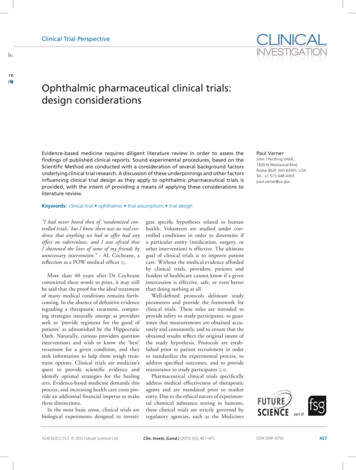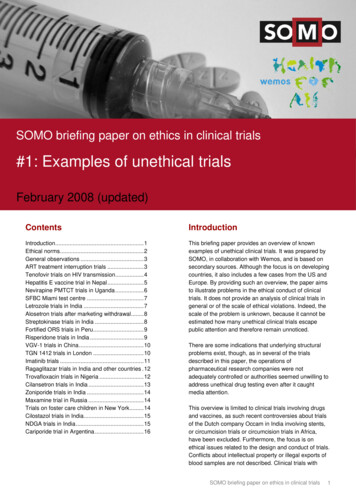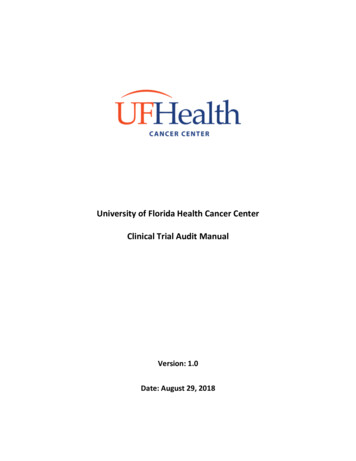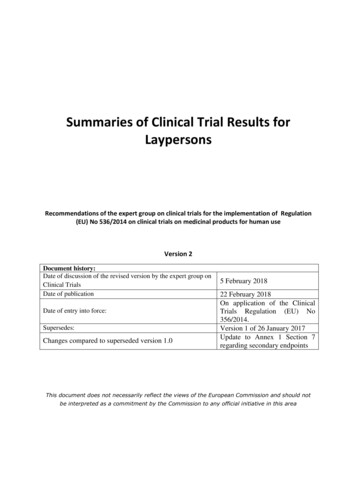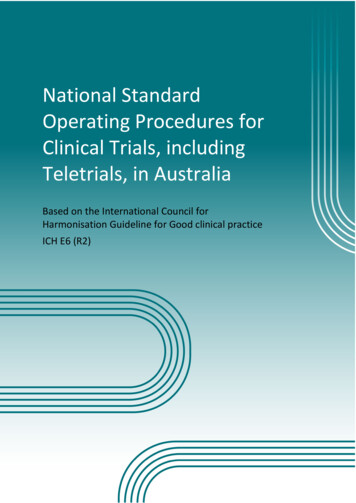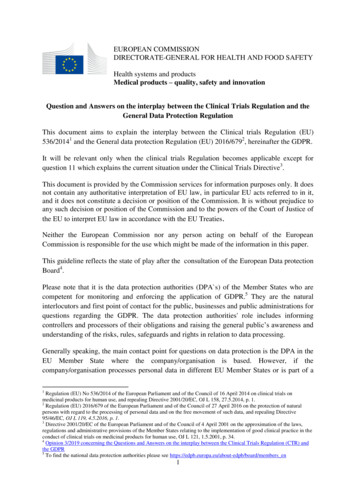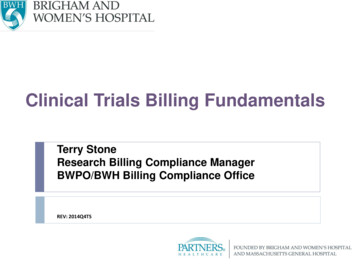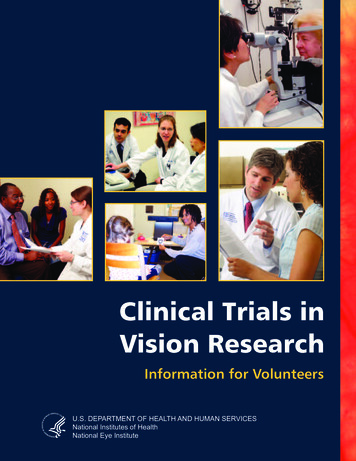
Transcription
Clinical Trials inVision Research Information for VolunteersU.S. DEPARTMENT OF HEALTH AND HUMAN SERVICESNational Institutes of HealthNational Eye Institute
Clinical trials in vision research haveled to new medications, surgeries, andmethods for disease detection.
ContentsClinical Trials in Vision Research1Basics of Clinical Trials3How a Clinical Trial is Conducted7Participating in a Clinical Trial11A Volunteer’s Bill of Rights17Questions to Ask Before Participating19Clinical Trials at NEI22
Clinical trials in vision research haveled to new medications, surgeries, andmethods for disease detection.
Clinical Trials in Vision Research If you or someone you know is thinking about takingpart in a clinical trial, this booklet may answer someof your questions. Clinical trials in vision researchhave led to new medications, surgeries, and methodsfor disease detection that have saved or improved theeyesight of millions of people.The National Eye Institute (NEI), one of the NationalInstitutes of Health (NIH), conducts and sponsorsclinical trials to discover safe and effective methods forpreventing, diagnosing, and treating eye disease andvision loss. Established in 1968, the NEI is the largestsponsor of vision research in the United States.1
Clinical trials are medical researchstudies in which people volunteer toparticipate.
Basics of Clinical TrialsWhat is a clinical trial?Clinical trials are medical research studies in whichpeople volunteer to participate. A clinical trial is usedto evaluate the safety and effectiveness of a newprocedure, medication, or device to prevent, diagnose,or treat an eye disease or disorder.Generally, medical research begins in laboratories.After a treatment shows promise in the laboratory, it istested in a study to determine if it will be beneficial forpatients.A clinical trial could test the effectiveness of a new drugfor age-related macular degeneration or a new surgicaltechnique for cataract removal.What are the types of clinical trials?The following four types, or phases, of clinical trialsexist: Phase I clinical trials test a potential new treatmentin a small number of volunteers to determine the bestdosage and identify potential side effects.3
Phase II clinical trials test a potential new treatmentin a larger number of volunteers to learn more abouthow the body responds to the treatment, the optimaldose of the treatment, and how the treatment affectsa certain eye condition.4
5 Phase III and IV clinical trials may include hundredsor thousands of volunteers around the country.These studies compare a new treatment with existingtreatments or no treatment to determine if the newtreatment works better, the same, or not as well.Phase III clinical trials are conducted to get the newtreatment approved by regulatory agencies. PhaseIV clinical trials are conducted after approval tounderstand more about the treatment.
Clinical trials are controlled, meaning thatresearchers compare the effects of a newtreatment with those of another treatment.
How a Clinical Trial isConductedThe researcher in charge of a clinical trial is called theprincipal investigator. The person who makes thearrangements for your visits and explains how the studyworks is called the clinic coordinator.Volunteers for clinical trials must meet certain eligibilitycriteria, which may involve age, type, and stage of aparticular eye condition, and previous treatment for thecondition.If you are eligible for a clinical trial and you agree toparticipate, you will be asked to sign an informedconsent. This document explains the main purposeof the study, the eligibility criteria, the treatment, thepossible risks and benefits, your rights as a patient, andwhat researchers expect from you.All of the doctors involved in the study follow a detailedtreatment plan known as the study protocol. Theprotocol ensures that all participants are treated in astandard way.7
Clinical trials are controlled, meaning that researcherscompare the effects of a new treatment with thoseof another treatment. This is done by dividing studyparticipants into groups. If you receive the newtreatment, you are in the treatment group. If you arein the control group, you could receive the standardtreatment for a particular eye condition. When astandard treatment does not exist, you may receive notreatment, a placebo, or a sham treatment.A placebo may be used in clinical trials that test a8medication. It is a harmless substance that lookslike the real medication but has no direct effect onan eye condition. A sham treatment may be usedin clinical trials that test a new surgery or device. Asham treatment, like a placebo, is safe and has nodirect effect on an eye condition. Placebos and shamtreatments are often used to understand both thepositive and negative effects of a new treatment.Researchers randomly assign participants to thetreatment and control groups. In most studies, you havean equal chance of being assigned to each of the studygroups. Though the study treatment may be effective
in some cases, new treatments may have serious sideeffects or may not be effective. During the clinical trial,there is no way for you or your doctor to know whichstudy group will have the best response to treatment.In a nonmasked trial, both you and your doctor willknow your group assignment. In a masked trial, youwill not know your group assignment. In a doublemasked trial, neither you nor your doctor will knowyour group assignment. Double masked trials help toensure that the results will not be affected by what youor your doctor might think about the treatment.How are clinical trials in vision differentfrom other clinical trials?Eyes are one of many body parts that come in pairs.This feature gives researchers some additional optionswhen they design the study. If an eye condition affectsboth of your eyes, one eye might be placed in thetreatment group for a study and the other may be inthe control group. Generally, the eye that will be treatedis randomly assigned.9
The success of a clinical trial oftendepends on learning what happens toparticipants over a long period of time.
Participating in a Clinical TrialWhat is expected of volunteers in aclinical trial?Participants in a clinical trial are expected to receive eyeexams and other testing. You may need to take a newmedication or undergo a new surgical procedure duringthe study. You may also be required to return to themedical facility for follow-up examinations. These examshelp determine how well a treatment is working. Suchfollow-up studies can last for months or even years.The success of a clinical trial often depends on learningwhat happens to participants over a long period oftime. Only participants who continue to return forfollow-up examinations can provide this importantlong-term information. These exams are essential forthe success of the study. You should consider this whenyou are deciding whether to participate in the clinicaltrial. The study results will not be valid unless almosteveryone who enrolls in the trial participates in thefollow-up exams.11
What are the benefits of participating?Participants in NEI studies are monitored by a team ofexpert doctors, nurses, technicians, and support staff.By participating, you may be one of the first people toreceive a promising new treatment. If the treatment iseffective, it may improve your vision or prevent an eyecondition from occurring.If you are in the control group and the treatment isfound to be safe and effective, you may be among thefirst to benefit from the treatment when the study ends.12All participants in clinical trials contribute to newknowledge that may help other people who experiencesimilar eye problems. If you have an eye condition thatruns in your family, your participation may also lead tobetter care for your family members.What are the risks of participating?Medical professionals have no method for predictingif a new treatment will work in a particular person.The treatment you receive could cause side effectsthat are serious enough to require medical attention.
Participants must understand that a new treatment maynot work better than a standard treatment, may notwork at all, or may be harmful.What if a volunteer’s health changesunexpectedly during the study?Your health is unpredictable. You could develop aserious medical condition during the study that iscompletely unrelated to your vision. If this happens,doctors may determine that it is in your best interest toleave the study. Your overall health always comes first ina clinical trial.How is patient safety protected?Before a clinical trial begins, researchers must getapproval from an Institutional Review Board. Thisindependent advisory group makes sure that a clinicaltrial is designed to be scientifically correct and toprotect patient safety.During a clinical trial, doctors will closely monitor youto see if the treatment is working and to identify anyside effects. All of these observations are recorded13
and reviewed. In addition, an independent group ofexperts known as the Data and Safety MonitoringCommittee carefully monitors every NEI-supportedtrial. This group can recommend that a trial be stoppedif the risks outweigh the benefits for participants or ifthe new treatment is so effective that it could be usedby everyone as soon as possible.14
What are the costs of a clinical trial?All medical care provided at the NEI medical facilityin Bethesda, Md., is free of charge. Clinical trialsconducted at other locations may involve costs relatedto standard medical care. These may or may not becovered by health insurance. You should discuss anypossible costs with your healthcare provider andinsurance company before enrolling in a clinical trial.15
You have the right to know all of the risksand benefits of the treatment involved inthe study.
A Volunteer’s Bill of RightsAs a participant in a clinical trial, you have the right to: Know all of the risks and benefits of the treatmentinvolved in the study. Know how, for how long, and where the researchersplan to carry out the study. Know what is expected of you in the study. Know any costs involved for you or your insurancecompany. Be aware of any medical and personal informationthat is shared with other researchers who are directlyinvolved with the study. Talk openly with doctors. Ask questions about the study. Leave the study at any time after enrolling. However,you should not enroll if you think you may be unableto complete the study. Receive any new information about the treatmentthat becomes available during the study. Be informed of your treatment assignment after thestudy is completed. Maintain your privacy even after your participationis completed. Your name should not appear in anyreports based on the study.17
Talk with your doctors, family members, andclinical trial staff to determine whether aparticular study is the right choice for you.
Questions to Ask BeforeParticipatingIt is important to completely understand the clinicaltrial before volunteering. Talk with your doctors,family members, and clinical trial staff to determineif a particular study is the right choice for you. Beforedeciding, be sure you know the answers to thefollowing questions:About the study: What is the purpose of this clinical trial? Why do researchers think the new treatment beingstudied may be better than the standard treatment? What is known about side effects from thetreatment? What tests and treatment will I receive? Will I need surgery or medications?19
Will I be hospitalized? How will the study benefit me? How will it benefitothers?About your health: How might the treatment benefit my eye condition? What are the possible short- and long-term risks andside effects of the treatment?20 What are the chances of any side effects occurring? How will my health be monitored during the study? Who will be in charge of my care? Will I be able tosee my own doctor?About your commitment: Will taking part in the study affect my daily life? How long will the treatment last? How often will I need to return for follow-up exams?
21 What is the total time involved? How much will it cost me to be in the study? How do I feel about taking part in a clinical trial?How do my family and friends feel about myparticipation?
Clinical Trials at NEIThe NEI Web site lists the clinical trials that are currentlyrecruiting volunteers. This list includes studies takingplace on the NIH campus in Bethesda, Md., and NEIsupported studies being conducted at clinical centersaround the country. Eligibility criteria are included foreach study.For more information about enrolling in an NEI clinicaltrial, go to http://www.nei.nih.gov/eyeclinic.22For more information about the NEI, contact:National Eye Institute2020 Vision PlaceBethesda, MD 20892-3655nei2020@nei.nih.gov301-496-5248For more information about clinical trials, visithttp://www.clinicaltrials.gov.
U.S. DEPARTMENT OF HEALTH AND HUMAN SERVICESNational Institutes of HealthNational Eye InstituteNIH Publication No: 09–4124Revised 08/09
may be used in clinical trials that test a medication. It is a harmless substance that looks like the real medication but has no direct effect on an eye condition. A . sham treatment. may be used in clinical trials that test a new surgery or device. A sham treatment, like a placebo, is safe and has no direct effect on an eye condition. Placebos .

